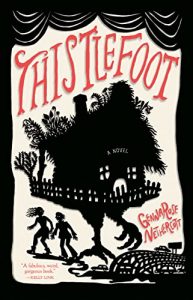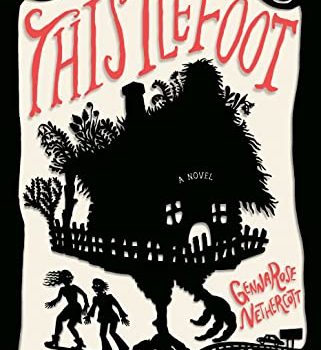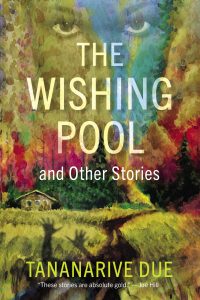Alexandra Pierce Reviews Thistlefoot by GennaRose Nethercott
 Thistlefoot, GennaRose Nethercott (Anchor 978-0-59346-883-8, $28.00, 448pp, hc) September 2022.
Thistlefoot, GennaRose Nethercott (Anchor 978-0-59346-883-8, $28.00, 448pp, hc) September 2022.
Baba Yaga’s chicken-footed house has been delivered to her descendants, estranged siblings living in the United States some three generations removed from their maternal ancestor. The siblings have no idea who their progenitrix was, why this house has come to them, or even really what to do with it; and they definitely don’t know that with the house they have also inherited a threat, the Longshadow Man, who will follow the house and do terrible things along the way.
This is the premise of Thistlefoot, GennaRose Nethercott’s debut novel (she has previously published a book of poetry, which shows through in her gorgeous prose). It’s partly a family story, about reconnecting after time and circumstance have driven you apart; it’s partly about being a witness to terrible things in history; it’s wholly a glorious modern folktale.
The Yaga siblings are the focus of the story. They grew up with parents running a puppet theater, which had its own ups and downs. As adults, Isaac is a grifter, who opens the story busking in New Orleans. He has a talent for mimicking the people he watches: not just copying their mannerisms, but copying everything about the way they carry themselves so that he suddenly seems like their twin. It might almost be magic…. His younger sister, Bellatine (whom Isaac calls Tiny, which is never explicitly called out but I can only imagine drives Bellatine to distraction), is a woodworker, who has managed to fashion a life for herself since Isaac left without saying goodbye several years ago. She has learned, over the years, important tricks to keep herself calm, since if she doesn’t then her hands are liable to do… difficult things. Things like encouraging life where life shouldn’t be, such as in puppets. They are both broken in different ways, discontent with aspects of their lives, and (if only they’d admit it) at a loss for what to do next.
While the Yagas are the focus, the center of the story is, in many ways, Thistlefoot itself: the house that Baba Yaga bequeathed her unknown descendants, in a will that stipulated nothing was to be done with it until 70 years after her death. Which is how the house finds itself in a box, in a shipping yard, in the US rather than Ukraine, owned by siblings who don’t want to spend any time together. Thistlefoot is the narrator of the novel, and in general confines itself to telling Isaac and Bellatine’s story; but occasionally it breaks in with commentary, or to give some account of its own history. It is an unreliable narrator about itself and Baba Yaga as a person, playfully suggesting several different origin stories and completely unconcerned with their veracity. What it’s not unreliable on, though, is the experience of the town where Baba Yaga lived. This is Gedenkrovka, in the west of what was then the Russian Empire; it’s a town with a large Jewish population. From Thistlefoot’s perspective, the most important part of the town’s history happens during the Russian Civil War after the Bolsheviks have had their revolution and various factions are fighting for control of the Russian Empire. As so often has happened in Europe in times of confusion and dissatisfaction and general violence, the targeting of Jewish populations became more severe. So there is a content warning attendant on this novel: it is about anti-Semitic violence. Thistlefoot and Nethercott insist that these moments in history be witnessed and remembered.
Thistlefoot is acquired, and the siblings agree to a deal: they will do a puppet tour together (to Bellatine’s horror), and Isaac gets the money as a way for Bellatine to buy out his share of the house. Thus they are on the move around the US, in their self-propelled house, which is why it takes so long for the Longshadow Man to track them down. Because the Longshadow Man has also arrived on American soil, tracking the chicken-footed house, and wreaking havoc as he goes. When the siblings finally become aware of the threat tailing them, they need to learn the history of their family to fully understand it; they also acquire companions along the way, and some appreciation of one another.
The tragedies of history are neither covered up nor sentimentalized in Thistlefoot: they are seen, and they are honored, and they are part of the story. This is a bit brave, and very honest. Nethercott isn’t moralizing, or didactic, or gratuitous in how she portrays the past. She has created a complex world here – so like ours but just a bit sideways; it’s an impressive debut.
Alexandra Pierce reads, writes, podcasts, cooks and knits; she’s Australian and a feminist. She was a host of the Hugo Award winning podcast Galactic Suburbia for a decade; her new podcast is all about indie bookshops and is called Paper Defiance. Alex has edited two award-winning non-fiction anthologies, Letters to Tiptree and Luminscent Threads: Connections to Octavia E Butler. She reviews a wide range of books at www.randomalex.net.
This review and more like it in the November 2022 issue of Locus.
 While you are here, please take a moment to support Locus with a one-time or recurring donation. We rely on reader donations to keep the magazine and site going, and would like to keep the site paywall free, but WE NEED YOUR FINANCIAL SUPPORT to continue quality coverage of the science fiction and fantasy field.
While you are here, please take a moment to support Locus with a one-time or recurring donation. We rely on reader donations to keep the magazine and site going, and would like to keep the site paywall free, but WE NEED YOUR FINANCIAL SUPPORT to continue quality coverage of the science fiction and fantasy field.
©Locus Magazine. Copyrighted material may not be republished without permission of LSFF.







